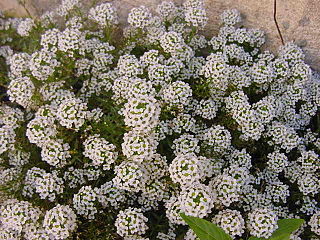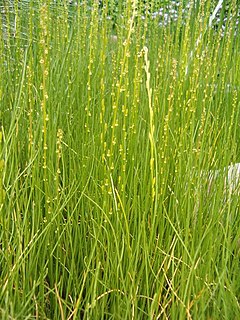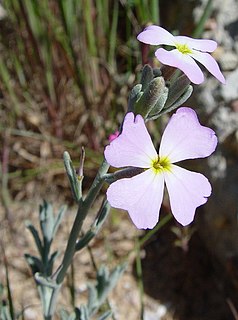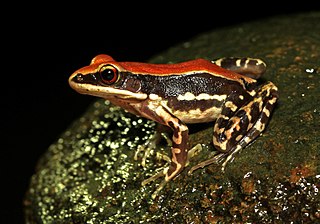
The Fabales are an order of flowering plants included in the rosid group of the eudicots in the Angiosperm Phylogeny Group II classification system. In the APG II circumscription, this order includes the families Fabaceae or legumes, Quillajaceae, Polygalaceae or milkworts, and Surianaceae. Under the Cronquist system and some other plant classification systems, the order Fabales contains only the family Fabaceae. In the classification system of Dahlgren the Fabales were in the superorder Fabiflorae with three families corresponding to the subfamilies of Fabaceae in APG II. The other families treated in the Fabales by the APG II classification were placed in separate orders by Cronquist, the Polygalaceae within its own order, the Polygalales, and the Quillajaceae and Surianaceae within the Rosales.

The true frogs, family Ranidae, have the widest distribution of any frog family. They are abundant throughout most of the world, occurring on all continents except Antarctica. The true frogs are present in North America, northern South America, Europe, Africa, and Asia. The Asian range extends across the East Indies to New Guinea and a single species has spread into the far north of Australia.

Scabiosa is a genus in the honeysuckle family (Caprifoliaceae) of flowering plants. Many of the species in this genus have common names that include the word scabious, but some plants commonly known as scabious are currently classified in related genera such as Knautia and Succisa; at least some of these were formerly placed in Scabiosa. Another common name for members of this genus is pincushion flowers.

Batis is a genus of two species of flowering plants, the only genus in the family Bataceae. They are halophytic plants, native to the coastal salt marshes of warm temperate and tropical America and tropical Australasia.

Lobularia maritima is a species of low-growing flowering plant in the family Brassicaceae. Its common name is sweet alyssum or sweet alison, also commonly referred to as just alyssum.

Lobularia is a genus of five species of flowering plants in the family Brassicaceae, closely related to the genus Alyssum. The genus is native to Macaronesia and the Mediterranean region, and comprises annuals and perennials growing to 10–40 cm (4–16 in) tall, with hairy oblong-oval leaves and clusters of cross-shaped (cruciform), fragrant white flowers.

Molinia, or moor grass, is a genus of two species of flowering plants in the grass family, native to damp moorland in Eurasia and northern Africa. They are both herbaceous perennial grasses.

Cakile is a genus within the flowering plant family Brassicaceae. Species in this genus are commonly known as searockets, though this name on its own is applied particularly to whatever member of the species is native or most common in the region concerned, the European searocket Cakile maritima in Europe, and the American searocket C. edentula in North America. The genus is native to Europe, Asia and North America, but the European searocket has been introduced into North America and has spread widely on both east and west coasts; in many places it is replacing the native C. edentula, and is regarded as an undesirable invasive species.

Triglochin is a plant genus in the family Juncaginaceae described by Carl Linnaeus in 1753. It is very nearly cosmopolitan in distribution, with species on every continent except Antarctica. North America has four accepted species, two of which can also be found in Europe: Triglochin palustris and Triglochin maritima. Australia has many more.

Malcolmia is a genus of flowering plants from the family Brassicaceae. Species from this genus are native to Europe and Africa.

Armeria is a genus of flowering plants. These plants are sometimes known as "lady's cushion", "thrift", or "sea pink". The genus counts over a hundred species, mostly native to the Mediterranean, although Armeria maritima is an exception, being distributed along the coasts of the Northern Hemisphere, including Ireland, parts of the United Kingdom such as Cornwall, and the Pembrokeshire Coast National Park in Wales.

Lysimachia maritima is a plant species belonging to the family Primulaceae. It was previously called Glaux maritima, the only species in the monotypic genus Glaux. The species has a number of common names, including sea milkwort, sea milkweed, and black saltwort.

Ruppia, also known as the widgeonweeds, ditch grasses or widgeon grass, is the only extant genus in the family Ruppiaceae, with eight known species. These are aquatic plants widespread over much of the world. The genus name honours Heinrich Bernhard Rupp, a German botanist (1688-1719). They are widespread outside of frigid zones and the tropics.

Alyssum is a genus of about 100–170 species of flowering plants in the family Brassicaceae, native to Europe, Asia, and northern Africa, with the highest species diversity in the Mediterranean region. The genus comprises annual and perennial herbaceous plants or (rarely) small shrubs, growing to 10–100 cm tall, with oblong-oval leaves. Alyssum flowers are characteristically small and grouped in terminal clusters; they are often yellow or white colored but can be pink or purple.

Proscillaridin is a cardiac glycoside, a kind of drug that can be used in the treatment of congestive heart failure and cardiac arrhythmia. It is of the bufanolide type and can be obtained from plants of the genus Scilla and in Drimia maritima.

Suaeda is a genus of plants also known as seepweeds and sea-blites. Most species are confined to saline or alkaline soil habitats, such as coastal salt-flats and tidal wetlands. Many species have thick, succulent leaves, a characteristic seen in various plant genera that thrive in salty habitats.

Strumpfia is a monotypic genus of flowering plants in the family Rubiaceae. The genus contains only one species, viz. Strumpfia maritima, which is found from southern Florida to northern Venezuela. Strumpfia maritima is also the only species in the tribe Strumpfieae. It is an evergreen shrub of coastal areas that rarely exceeds 1 m (3.3 ft) in height. Pride of Big Pine is a common name. Strumpfia was named by Nicolaus Jacquin in 1760 in his compilation entitled Enumeratio Systematis Plantarum. It was named for Christopher Strumpf, professor of chemistry and botany at Hall, in Magdeburg, and editor of Carl Linnaeus's Genera Plantarum.

Suaeda maritima is a species of flowering plant in the family Amaranthaceae known by the common names herbaceous seepweed and annual seablite.
Phylohydrax is a genus of plants in the Rubiaceae. It contains two species:

Hydrophylax is a genus of true frogs. They are found in South and Southeast Asia.


















